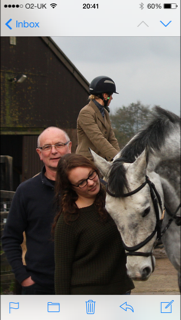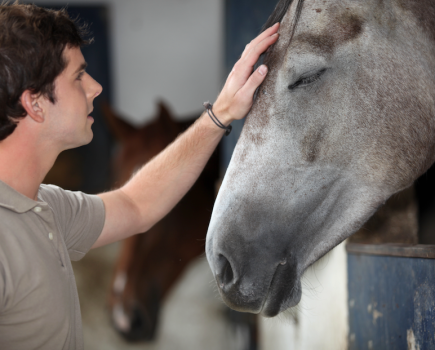In her blog for Your Horse, Beth from XLVets Equine explains about a tough decision she had to make.
Working with horses all day, every day, it’s easy to become complacent about the risks of our job.
We’re all wary of the horses who have a reputation of being difficult or give you the tell tale signs as soon as you enter a stable, but this week my horse definitely reminded me of their unpredictable nature.
My parents bought Ink, a 17.2hh Irish Sports Horse, as a promising four-year old from Ireland with the intention of eventing him with a professional rider, who I have groomed for in the past.
Unfortunately, at the beginning of his first season he became very mildly forelimb lame.
Extensive investigations ensued at one of the country’s top referral centre, but they couldn’t find a cause. We trialled a period of box rest to no avail and then a period of field rest, but the lameness persisted.
Almost a year after the original lameness, I decided to return him to work on phenylbutazone, hoping that I could give him at least some sort of purpose, even if it couldn’t be the original career we had intended him for.
However, not long after starting ridden work he began tripping excessively even when in the school.
At this point I decided to get some neck x-rays as I was concerned that as a young, fast growing, Warmblood there was a good chance he could have cervical vertebral malformation, also known as ‘wobblers syndrome’. This is a condition resulting in the horse being unaware of where there legs are in space.
The neck x-rays revealed moderate arthritis of several of the joints in his neck. This isn’t uncommon, especially in Warmblood and Thoroughbred horses and is thought to develop secondary to OCD lesions (abnormal bone/cartilage development) in these joints.
The additional bone formed as part of the disease can compress the spinal cord if it forms on the inside of the joints and this is what causes the ataxia (or wobbliness).
At this point Ink was Grade 1/5 ataxic, which is the lowest grade of ataxia and is relatively common in Warmbloods. We retired him at this point, almost a year ago and he has lived in luxury as a field/stable ornament ever since.
He’s shown some deterioration in the last couple of months and recently I would’ve graded him as grade 2/5 ataxic.
On Saturday morning I had him on the yard, getting him ready to turn out, and he trod on his lead rope, pulled back and broke it.
I grabbed his head collar, which caused him to pull back again. He’s always been a very bold, cheeky character, so irritated that he was overreacting, I kept hold of his headcollar. Next thing I knew, approximately 650kg of horse had landed knees first onto my back.
I assume that the altered head and neck position had caused an increase in pressure on his spinal cord resulting in the sudden deterioration in balance.
I was very lucky to walk away with just a couple of broken ribs, but the incident highlighted to me the potential dangers of keeping such a big horse with a worsening neurological disorder.
My parents and I realised very quickly that we had a difficult decision to make.
As a vet I spend a fair amount of time counselling clients about euthanasia and when the appropriate time is to make that decision for your four-legged friends.
In most cases I find myself consoling clients with the knowledge that they’re doing the kindest thing and making a selfless decision for the sake of their horse. However, neurological horses are often, happy and well in themselves and this was definitely the case with Ink.
The decision to euthanase them is usually made because they are no longer safe to handle, not only for the owner, but also for other people on the yard, the farrier, the dentist and anyone else involved in their care.
This often makes the decision especially tough and certainly for me I felt incredibly selfish for putting to sleep a horse who was still so full of life. Although saying goodbye to him was extremely difficult, and he’ll be greatly missed, in my opinion it was the only option after what happened.
Having a near miss with a horse who was such a gentle giant, has highlighted to me the dangers of handling neurological horses, even those without severe clinical signs.
Every case is different, each cause of ataxia has different treatment options and predicted progression. This should be discussed in detail with your vet if you have any concerns.
I hope that sharing this story will help anyone else who has made the decision to euthanase a neurological horse or has to make that decision in the future to recognise the wisdom of their actions.









